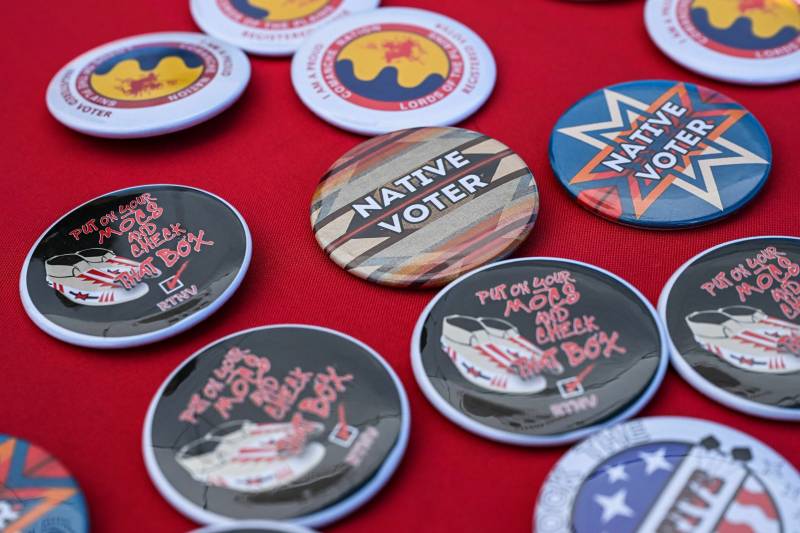“Western Native Voice, according to Perez, is already working on voter registration efforts — initiatives they usually don’t begin this far ahead of an election.
“[Native voters in Montana] have the ability to really determine the balance of power in the Senate,” Perez said, adding that it is particularly impactful for those living on reservations where federal funding directly impacts the services available. But it is still not quite a shoo-in for Democrats.
“I would go as far as to say that the Democratic Party assumed that there would be just robust automatic turnout for them. But there were some races [in 2022] that were closer than what was expected,” Perez said.
He said the key here is turnout and ensuring that candidates and parties make a direct connection with voters and inform them of upcoming elections.
“If any of the parties, if any candidate wants to reach out to Indian Country and wants to energize voters to go out to the polls, they need to go there in person,” Perez said. “They can’t rely on surrogates. They can’t rely on influencers.”
Nevada
The more than 62,000 Indigenous people living in Nevada, who generally account for 3.5% of the state’s population, have been credited with helping Democrats secure wins in recent elections.
“We know that Native American voters in what is now the state of Nevada are voting in bigger numbers,” said Stacey Montooth, executive director of the Nevada Indian Commission, a state agency. “There are thousands and thousands of Native Americans who want to be involved in the process.”
Montooth said that as a result of lawsuits, there are services in the state that make it easier for Indigenous voters to vote including laws requiring any voting services available to Nevadans generally be available on tribal land as well.
“It makes such a huge difference when our elders don’t have to drive 90 miles to cast their ballot,” Montooth said. “They can go to their senior center or give their completed ballot to a tribal health care worker.”
All Voting is Local, a voting rights group with a Nevada chapter, pointed to an increase in Native American turnout rates in 2020 compared to 2016 as a reason why mail-in ballot efforts from the pandemic should be expanded and made permanent. The measure was passed ahead of the 2022 midterm elections.
“We know that we have more eligible voters than all but two counties in the state. … But when Indian Country in the Great Basin, when we galvanize, we have a lot of political clout,” Montooth said. “I always love to hear that Nevada is influential when it comes to national politics. But my heart is warmed because I know the original caretakers of this land — we have something to do with that, too.”
North Carolina
Around 3% of North Carolina’s population identifies as Native American or Alaska Native.
That includes the Lumbee Tribe, which is state-recognized but, unlike 574 tribes across the country, is not fully federally recognized. The tribe, concentrated in the southeast portion of the North Carolina around Robeson County, has notably grown more conservative in recent presidential elections, voting Democrat until 2016, when it flipped for Trump, who supported its federal recognition.
“North Carolina has a very active Native caucus that’s a very large Native electorate,” said Judith LeBlanc, executive director of the Native Organizers Alliance, adding that while Indigenous voters could trend Democrat, they also will vote Republican.
Biden’s campaign is already investing in the state generally, three years after he lost it by just under 75,000 votes. Some say that the Democratic party took the Native vote for granted in the last election.
The Eastern Band of Cherokees is the only federally recognized tribe within North Carolina. It has about 16,000 members. Although the district where the tribe is located is primarily Republican, tribal members have also been known to vote for Democrats.
“Don’t ignore the Cherokee vote,” warned Wilson Pipestem, counsel to the Eastern Band of Cherokee Indians. “Both parties need to reach out to the Eastern Band of Cherokee Indians and let us know what you stand for. And we want to hear from you.”
Wisconsin
Wisconsin is another key state that helped deliver Biden a win after voting for Trump in 2016. There, 2.5% of the population identifies as American Indian or Alaska Native.
Wisconsin Native voters, like in other aforementioned states, are credited with helping deliver Biden a win in 2020 along tight margins.
Dee Sweet, manager for Wisconsin Native Vote, boasts increasing voter turnout across the 11 federally recognized tribes in the state and said she noticed an increased interest in the electoral process.

9(MDAxOTAwOTE4MDEyMTkxMDAzNjczZDljZA004))
